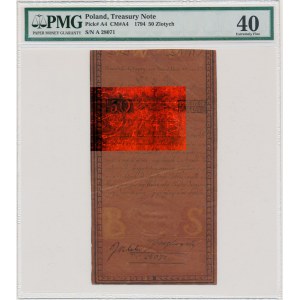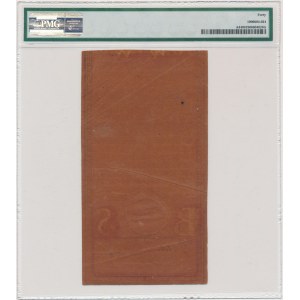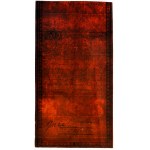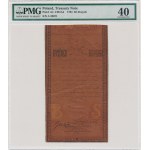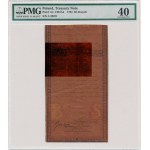Great rarity!
The Kościuszko banknote printed on paper with the WR filigree, which, according to Robert Jadrych's doctoral dissertation, constitutes the royal monogram.
Quoting from Czesław Miłczak "It is very rare to come across banknotes printed on paper from other Dutch factories, such as: GR, HR, WR"
This is also proven by the fact that while reviewing the archived auction quotation, we did not find any quotation for Kościuszko's note with the WR filigree, and therefore the offered piece is the first to be offered at the auction market. Naturally, it cannot be ruled out that such items were listed in the past, but were not described by the auction houses offering them. However, awareness among collectors of Polish paper money about rare filigrees has been present for several years, but we still have not seen their quotations until now. We have been paying attention to filigree for a long time and, based on conversations with advanced collectors of Kościuszko banknotes, we believe that there is only one other piece known in private collections. This means that only two examples were recorded in total!
The offered banknote graded PMG 40.
A natural note with beautifully preserved red color of the print. The dry stamps are legible, which suggests that the banknote was printed on thick paper. The edges are naturally smooth, without cuts. The banknote retains full printing freshness, without traces of any washing or pressing.Great eye appeal.
The Kościuszko ticket being the subject of the auction will be appreciated primarily by experienced collectors with many years of experience who, based on their experience, understand what a rare note we have the pleasure of dealing with. It is worth emphasizing that despite the enormous popularity of Kościuszko period and rising prices, rare and unconventional filigrees still do not appear at auctions. Absolute rarity in an attractive natural condition.
In Poland, the introduction of paper money into circulation was related to expenses related to the outbreak of the Kościuszko Uprising. Its issuer was the Directorate of Treasury Tickets appointed by the Supreme National Council. In terms of value, treasury tickets were equal to a coin. Liabilities to the State Treasury could be repaid in a maximum of 50% in paper money and the remaining part in coins. This condition resulted in his negative perception by society. In the future, the purchase of treasury tickets was to be financed from national assets. The penalty for counterfeiting paper money was death and confiscation of all the perpetrator's property. On September 29, 1794, in order to strengthen confidence in treasury tickets, the Supreme National Council allowed the entire amount to be paid in paper groszes and zlotys. Due to the failure of the uprising, public trust in paper money decreased. The population preferred to accept metallic money in settlements. The scope of the issue of the first Polish paper money was small - they were introduced on a large scale only in Warsaw. After the capital was captured on November 6, 1794, the people were left with tickets of all denominations for a total amount of PLN 7.8 million.
On June 8, 1794, the Supreme National Council resolved to establish an issuing institution - the Directorate of Treasury Tickets - and to introduce treasury tickets in denominations of 5, 10, 25, 50, 100, 500 and 1,000 Polish zlotys. Treasury notes with an issue date of June 8, 1794 are very similar to each other. These are single-sided prints in the form of a standing rectangle, differing only in colors and details in the frame. Each denomination was hand-numbered and signed by two or three representatives of the Treasury Tickets Directorate. Additionally, each ticket has a dry stamp of the Treasury Tickets Directorate.
After printing, paper money of the same denomination was stapled together in the form of a cloth-bound "book". When they were put into circulation, they were hand-cut, which is why tickets of one denomination differ in dimensions and the shape of the upper edge. The part remaining in the "book" and the currency released into circulation have the same number.
